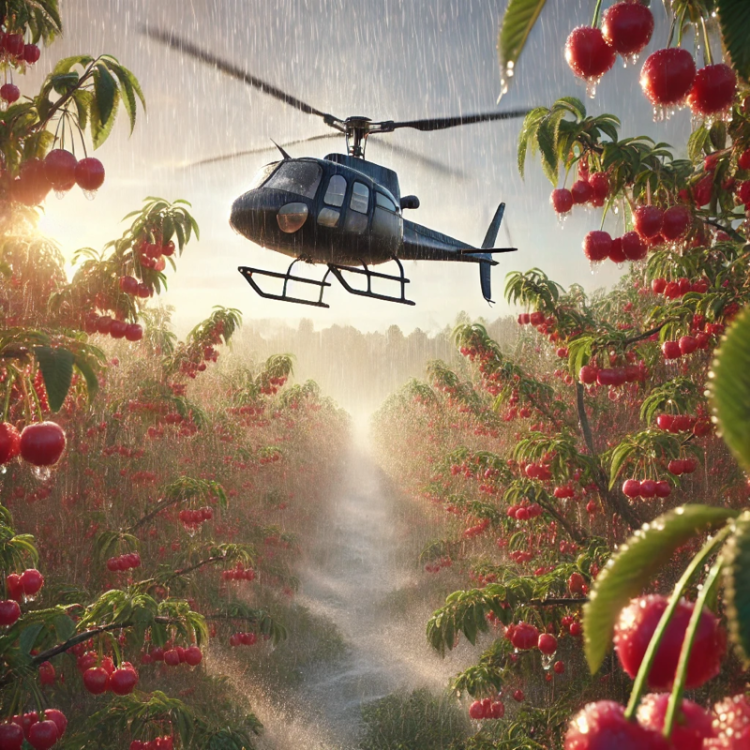Why Helicopters Help Save Cherries: The Delicate Art of Cherry Farming — a Glimpse of Wonder entry™ —
Cherry farming is as much a science as it is an art. One of the most striking examples of this is the use of helicopters to blow rain off ripened cherries. These powerful machines fly just above the treetops, producing a downwash of air and turbulence that blows rainwater off the leaves and fruit. Without this intervention, rainwater can seep into the cherries’ thin skin, causing them to swell, crack, and become unsellable. While the process may take some time depending on orchard size and conditions, it is an effective solution to one of cherry farming’s greatest challenges.
Fragile Fruits, Precise Handling
This level of care doesn’t stop with rain protection. Cherries are among the most fragile fruits, requiring precise handling from the moment they ripen on the tree. Harvesting is typically done by hand to prevent bruising, with workers carefully plucking the fruit, stem and all. Keeping the stem intact helps maintain the fruit’s freshness and reduces spoilage.
Once cherries are harvested, timing is everything. Immediate cooling is essential to halt the natural breakdown of the fruit. Farmers often use hydro-cooling, where cherries are submerged in chilled, chlorinated water at about 34°F (1°C). Another method, forced-air cooling, circulates cold air around the fruit to rapidly reduce its temperature. These techniques preserve the cherries’ firmness and sweet flavor, ensuring they reach consumers in peak condition.
Guarding Against Nature’s Challenges
Before cherries even make it to the harvest stage, farmers must contend with various challenges posed by nature. Birds, drawn to the bright red fruit, can devastate an orchard if left unchecked. Farmers use a range of tools to deter these unwanted visitors, including fine mesh nets, reflective devices, and sound cannons. The effectiveness of these methods can vary, so farmers often employ a combination of strategies to minimize damage.
In addition to birds, pests and fungal diseases present persistent threats to cherry crops. Farmers employ integrated pest management (IPM) strategies to monitor and control pest populations while minimizing environmental impact. Fungicides may also be used in wetter climates to prevent the spread of harmful fungi that can ruin the crop.
Growing for Perfection
Every cherry begins with careful planning and precise farming techniques. Pruning is one critical task, helping farmers shape their trees to ensur e that sunlight reaches every branch. This not only improves airflow, reducing the risk of disease, but also encourages even ripening of the fruit.
e that sunlight reaches every branch. This not only improves airflow, reducing the risk of disease, but also encourages even ripening of the fruit.
Irrigation management is another essential practice. Cherries are highly sensitive to water, and excessive rainfall or over-irrigation close to harvest can cause the fruit to crack. Farmers use advanced irrigation systems to provide just the right amount of water, maintaining a delicate balance that keeps the trees healthy without risking the crop.
A Symphony of Care
From the moment blossoms appear on the trees to the final shipment of fruit, cherry farming demands extraordinary attention to detail. Farmers must juggle weather challenges, pest control, pruning schedules, and post-harvest handling to ensure their fruit is as perfect as nature intended. Whether they’re deploying helicopters to dry rain-soaked cherries or using nets to ward off hungry birds, their dedication is a testament to the artistry and science behind every cherry we enjoy.
A Reflection on Jehovah’s Creativity
The intricacy of cherry farming reminds us of the remarkable designs in Jehovah’s creation. Each cherry tree is a testament to His wisdom, producing not just delicious fruit but also the beauty of spring blossoms and the life-giving shade of its branches. Jehovah has endowed humans with the intelligence and creativity to cultivate these gifts, adapting to nature’s challenges with innovative methods. As Psalm 145:16 says, “You open your hand and satisfy the desire of every living thing.” From the delicate balance of water that nourishes cherries without causing them to crack, to the vibrant colors and sweet flavors that delight us, every detail reflects His care and generosity in providing for mankind.
Sources
1. BC Cherry Association: Helicopter use for cherry drying.
2. NYS Horticultural Society: Post-harvest cooling techniques for cherries.
3. University of California Agriculture and Natural Resources: Irrigation management in cherry farming.
4. Washington State University Extension: Integrated pest management for cherries.
5. New World Translation of the Holy Scriptures: Psalm 145:16.
Edited by dljbsp
- hatcheckgirl, just1-4all, Palmitero and 1 other
-
 2
2
-
 2
2

2 Comments
Recommended Comments
Join the conversation with your brothers and sisters!
You are posting as a guest. If you are already a member, sign in now to post with your existing account.
Note: Your post will require moderator approval before it will be visible.